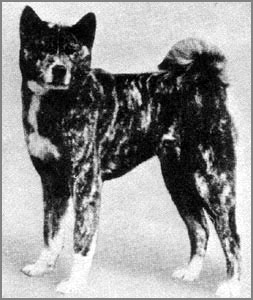|
Akita-Inu = Akita Dog
The Japanese refer to the Akita as their
ICHIBAN ... Number
One
and speak of him affectionately as being
tender in heart and strong in strength
- the dog that begins where others leave off.

Photo from The complete Akita
Japanese
Grand Champion
TOSHIME-GO
- a female Meiyosho
winner
|
The MEIYOSHO, the highest award that can be attained by
an Akita in Japan, is awarded to dogs and bitches at
Headquarters-sponsored shows. Only dogs and bitches who have
achieved the TOKUYU rating qualify.
TOKUYU - Superior (awarded to Senior Dogs and Bitches
only)
These dogs are
considered to have extra special qualities. A
MEIYOSHO winner is
not merely the top winning dog of a particular Headquarters
show. As the Akita is judged according to an absolute Standard,
a given show may produce a MEIYOSHO winner, may not produce a
winner, or it may produce more than one winner.
Therefore, these
winners may be considered the Grand Champions of AKIHO
shows. A
MEIYOSHO
winner can never compete again, only be
exhibited.
In 1927, Mr. Shigeie (Mokke) Izumi, the mayor of Odate, capital
of the Akita Prefecture, set up
the Akita Inu Hozonkai (AKIHO)
for the purpose of perpetuating true Akita dogs and in 1931 the
breed was officially named along with six other Japanese breeds.
The Akita Inu, as it was named, was declared a natural monument.
|
Two main Akita
lines
Many famous old
time Akitas stem from the ICHINOSEKI line which still flows
through the blood of today's Alkita dogs. Ichinoseki Goma-Go, call
name Tsubaki Goma, was an aka goma (red sesame) coloured male, he
stood 27,5 inches tall. He was an imposing animal despite his weak
rear and looseness of body. When bred to Futatsui Goma-Go (Matagi
line) they produced the famous Goromaru-Go, regarded by many as the
most important dog in the effort to bring the breed up to the Akita
Standard after the ravages of World War II.
GOROMARU-GO and
his three littermates were born January 8, 1948. Mr. Susumu
Funakoshi bought Goromaru and recalls he was a precocious red and
white pinto puppy with a large head, longer than average coat and
rather small, deep set triangular shaped eyes. The excellent quality
of Goromaru offspring down through the years brought fame to this
dog. When bred to the Ohira line of Akitas, e.g. Chimpei-Go and
Shiro Shiromaru-Go, the results were spectacular, despite warnings
from breeders who claimed the country-bred pinto would reproduce his
colour, not in favour at that time, and throw long coats known as "Moku".
The DEWA
line
existed at the same time as the Ichinoseki line. It derived its name
from the black tip male
DEWA-GO
who was born February 1, 1941. It is
said the ancestral dog behind him was Tachi-Go aka "Yari". The most famous of
Akita ancestors in Japan was Dewa-Go's Great Grandson
KONGO-GO. He was considered the ultimate prototype of the Dewa line.
The kurogoma colour (black sesame) dominated the Dewa line and was
genetically very powerful. It held for generations. Kongo-Go was owned by Mr. Heihacki
Hashimoto.
Although high
awards were given Kongo-Go and his son Japanese Grand Champion
KINCHO-GO during the time
breeders were trying to restore the Akita dog to what it had been in
the past, the Dewa line declined by degrees. One would be
hard-pressed to find its phenotype in Japan today.
The descendants of Kongo-Go became the foundation
stock of American breeders in the mid-1950,s. According to one
Japanese judge, the greatest difference between Japanese- and
American-bred Akitas is that the latter still show much evidence
of the Dewa strain.
According to the late
Mr. Naoei Sato, the Akita dogs of the Dewa line were noted for their
large stately build and gentle temperament as houshold dogs, and yet
were firm in their stand when necessary. However, the Dewa line soon
began to lose its value as a representative of the Akita dog breed
with the appearance of looseness of skin under the throat, loose
baggy lips and other features which led to a departure from the
Japanese dog image.
Much of the historically famous foundation stock was produced
between 1948 and 1950. Ichinoseki and Dewa emerged as the two main
breed lines. The son of Japanese Grand Champion Kincho-Go,
Japanese Grand Champion KINSHO-GO, was
the result of a combination between these two lines as Gomaru-Go was
his Great Grandfather (maternal). Dogs bred from them made their way to the United States
in the 1950s and 1960s when servicemen stationed in Japan after the
war brought the Akita stateside.
The Akita Club of America was founded
in 1956. Several Japanese standards were incorporated into its
standard for the breed. In 1973, the breed was accepted into the
American Kennel Club's Working Group. In 1996, the Akita ranked 35th
among the 143 breeds the AKC registered, with 11,161 dogs listed.
Part
of the text and photos
have been compiled from the book,
The complete Akita, by Joan M Linderman and Virginia Funk.
|